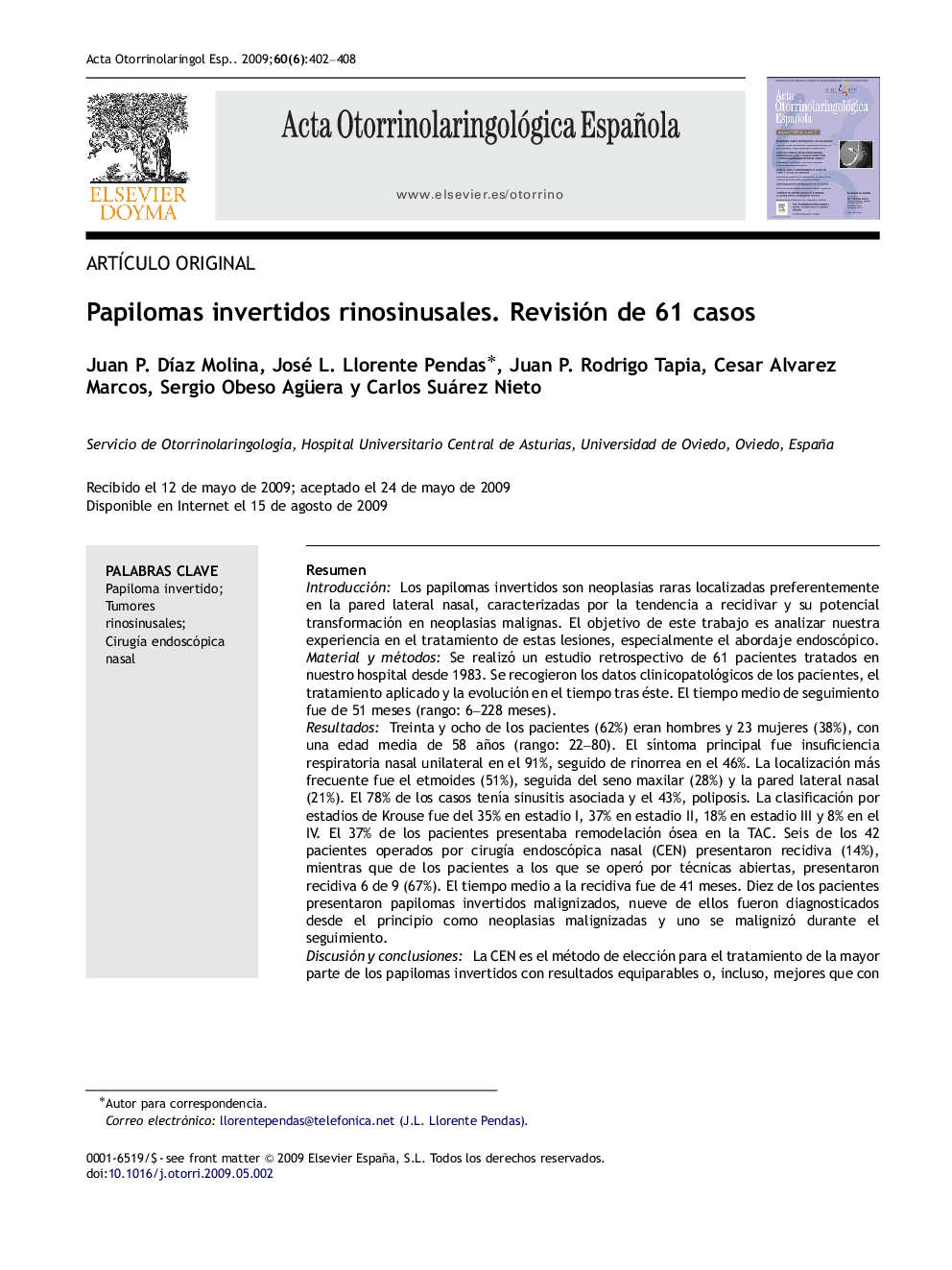| Article ID | Journal | Published Year | Pages | File Type |
|---|---|---|---|---|
| 4102091 | Acta Otorrinolaringológica Española | 2009 | 7 Pages |
ResumenIntroducciónLos papilomas invertidos son neoplasias raras localizadas preferentemente en la pared lateral nasal, caracterizadas por la tendencia a recidivar y su potencial transformación en neoplasias malignas. El objetivo de este trabajo es analizar nuestra experiencia en el tratamiento de estas lesiones, especialmente el abordaje endoscópico.Material y métodosSe realizó un estudio retrospectivo de 61 pacientes tratados en nuestro hospital desde 1983. Se recogieron los datos clinicopatológicos de los pacientes, el tratamiento aplicado y la evolución en el tiempo tras éste. El tiempo medio de seguimiento fue de 51 meses (rango: 6–228 meses).ResultadosTreinta y ocho de los pacientes (62%) eran hombres y 23 mujeres (38%), con una edad media de 58 años (rango: 22–80). El síntoma principal fue insuficiencia respiratoria nasal unilateral en el 91%, seguido de rinorrea en el 46%. La localización más frecuente fue el etmoides (51%), seguida del seno maxilar (28%) y la pared lateral nasal (21%). El 78% de los casos tenía sinusitis asociada y el 43%, poliposis. La clasificación por estadios de Krouse fue del 35% en estadio I, 37% en estadio II, 18% en estadio III y 8% en el IV. El 37% de los pacientes presentaba remodelación ósea en la TAC. Seis de los 42 pacientes operados por cirugía endoscópica nasal (CEN) presentaron recidiva (14%), mientras que de los pacientes a los que se operó por técnicas abiertas, presentaron recidiva 6 de 9 (67%). El tiempo medio a la recidiva fue de 41 meses. Diez de los pacientes presentaron papilomas invertidos malignizados, nueve de ellos fueron diagnosticados desde el principio como neoplasias malignizadas y uno se malignizó durante el seguimiento.Discusión y conclusionesLa CEN es el método de elección para el tratamiento de la mayor parte de los papilomas invertidos con resultados equiparables o, incluso, mejores que con las técnicas abiertas. El estrecho seguimiento de los pacientes por largos períodos de tiempo es necesario para detectar de forma precoz las recidivas y poder practicar cirugías de rescate.
IntroductionInverted papillomas are benign sinonasal lesions that arise primarily from the lateral nasal wall which are characterized by their tendency to recur and propensity to be associated with malignancy. The aim of this work is to analyze our experience in the treatment of these lesions, especially through the endoscopic approach.Material and methodWe present 61 cases of sinonasal inverted papillomas that were treated at our hospital since 1983. The patients were studied by age, gender, site of presentation of the tumor, symptoms, radiologic studies, surgical treatment and evolution. The mean follow-up was 51 months (range 6–228 months).ResultsThirty eight of the patients (62%) were males and 23 females (38%). The average age was 58 years (range 22–80). The most common symptom was unilateral nasal obstruction in 91% of the cases, followed by rhinorrhea in 46%. The most frequent location was the ethmoid region in 51% of cases, followed by the maxillary sinus in 28% and the lateral nasal wall in 21% of the cases. 78% of cases had associated sinusitis and the 43% polyposis. Tumours were classified with the Krouse staging system as follows: 35% stage I, 37% stage II, 18% stage III and 8% stage IV. 37% of the patients had bony erosion in the CT scan. Six of the 42 patients treated by endoscopic procedures presented recurrence (14%), compared with 6 of the 9 patients (67%) who were treated by open approaches. The average time to the recurrence was 41 months. 17% of the patients had malignant inverted papillomas, nine of them diagnosed from the beginning as malignant neoplasies and one which became malignant during follow up.Discussion and conclusionsThe endoscopic approach is the method of choice for the treatment of the majority of inverted papillomas. The close follow up of the patient for a large period of time is necessary for the early detection of recurrence and to allow for surgical salvage.
